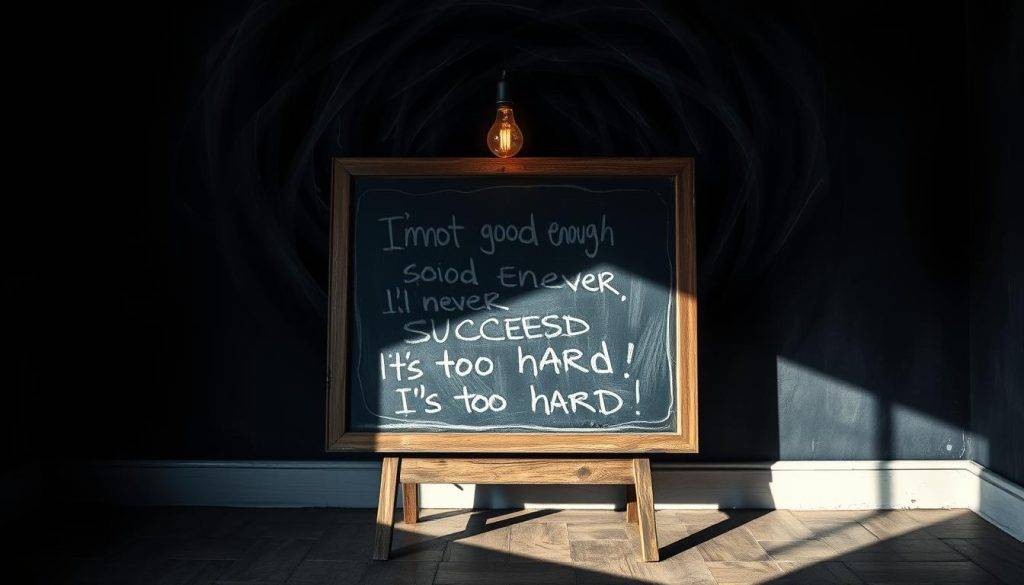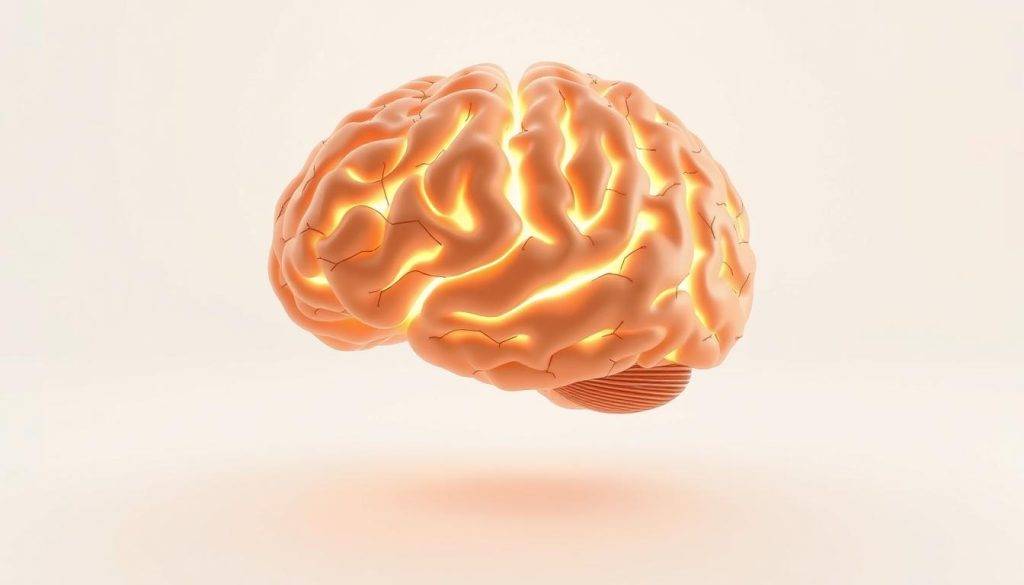“The only limit to your impact is your imagination and commitment.” — Tony Robbins
Affirmnosis offers a clear, practical route to shift beliefs and shape daily reality. This method blends affirmations, visualization, hypnosis, and biohacking into a short, repeatable routine. It shows how repeated thoughts, charged with feeling, guide the brain toward measurable outcomes in life and success.
The subconscious runs most decisions; precise, present-tense statements change that pattern. With consistent practice, inner signals align with outer behaviors—compounding gains in money, clarity, and well-being. Readers will find step-by-step tools to direct attention, strengthen personal power, and track progress.
Key Takeaways
- Affirmnosis combines focused statements, sensory rehearsal, and habit design to produce real changes.
- Emotion and repetition make thoughts stick—this rewires the brain toward new habits.
- Precise, present-tense beliefs help the subconscious support wealth and opportunity.
- Short daily rituals translate inner shifts into visible gains in life and career.
- Tracking checkpoints keeps progress measurable and adjustments practical.
Reprogram Your Mind for Abundance: The Present-Moment Path to Wealth, Clarity, and Success
Immediate focus acts like a lever: what you choose to notice today shapes tomorrow’s outcomes. In this way, the present moment becomes the most useful tool to shift thinking and create real results.
Decide clearly now. Setting a specific outcome brings fast clarity and directs the mind toward abundance. When thoughts target exact behaviors and numbers, daily choices sort themselves around those priorities.
Focused attention calms scattered thinking. It builds a practical mindset and boosts the power to act rather than hesitate.
- Choose one outcome in the moment and state it plainly.
- Pair that statement with a tiny daily habit that proves progress.
- Use emotion to make thoughts feel urgent and true.
That simple loop—decide, act, observe—rewires beliefs and supports subconscious reprogramming. It replaces old narratives that keep life stuck and creates momentum toward success and abundance.

How Your Subconscious Mind Shapes Money, Success, and Reality
Hidden templates in the mind decide familiar responses long before thought reaches awareness. This is why simple choices—what to spend, when to speak up, which job to take—often feel automatic.

The conscious mind manages deliberate tasks, while the subconscious mind stores values, habits, and scripts formed years ago.
Implicit memory keeps emotional tags from childhood—those deeply ingrained scarcity messages—active in adult life. People then act as if past events are present.
- The subconscious mind filters what reaches awareness, steering career and money decisions.
- Emotion plus repetition functions like programming, strengthening neural pathways in the brain.
- When thoughts focus on possibility and are felt, behavior shifts—risk tolerance and problem-solving improve.
“Old patterns replay until they are deliberately rewritten at the belief level.”
Understanding these mechanisms removes self-blame. It reframes setbacks as signals you can train and change, so future life is not a rerun of years ago conditioning.
The Affirmnosis Method: Decide, Commit, Resolve
A focused plan shifts scattered effort into steady progress. A crisp decision creates a mental blueprint that directs thought and action toward measurable goals.

Decide
Decide gives the subconscious a map. Clear targets define what wealth, work, and daily life look like.
When clarity exists, the brain allocates attention and energy to the chosen path.
Commit
Commit means acting despite fear. Small, repeated moves build mental muscle the way reps build the body.
Short actions—ten minutes, one call, a new habit—prove the decision to yourself and raise your level of consistency.
Resolve
Resolve keeps you adaptive. Feedback beats perfection; progress beats paralysis.
Use results to tweak tactics, keep control of direction, and protect long-term momentum in life and work.
- Decide: set a concrete target so the mind knows where to go.
- Commit: take action under stress to grow strength and confidence.
- Resolve: learn fast, adjust, and keep moving toward success.
“Decide, act, and refine — that loop turns intention into real change.”
Identify and Recode Limiting Beliefs for Mindset and Money
Old scripts about worth quietly block offers, raises, and new clients. Naming those limiting beliefs shrinks their power and makes them workable.
Spot the story. Common lines—“I’m not good enough,” or “Who am I to get rich?”—act like automatic commands. Write them down; naming a belief separates it from identity.
Spot the story
Map where each belief began. Many tags come from years ago and are deeply ingrained in memory.
Resolve conflicts
Conflicting beliefs cancel progress. Wanting abundance while believing “rich people are greedy” creates a stalemate that slows money decisions.

Use DICCC to recode
Marisa Peer’s DICCC—Direct, Instruct, Command, Compel, Code—gives specific present-tense lines the conscious mind can follow.
- Begin by surfacing core stories about worth and wealth; naming them reduces grip.
- Apply DICCC to install clear, contextual statements tied to real money actions.
- Create a short daily ritual to reprogram subconscious and watch behavior shift.
Question accuracy: ask, “Is this belief actually true? Does it help the life I choose now?” As beliefs change, small choices—asking for more, saying yes to opportunities—start to follow.
Affirmations that Actually Work: Emotionally True, Clear, and Present-Tense
Effective statements hook belief by matching what the body already accepts. Start with a short intro phrase if a strong “I am” feels false. Bridge lines—like “I’m willing to choose…”—soften resistance and make change gradual.

Specificity matters. Use measurable lines: “I’m earning $10,000 monthly doing work I love.” That exactness tells the mind what success should look like and guides daily choices.
Schedule three tiny reps: morning, a mid-day reset, and before sleep. Repeat across days and weeks so repetition plus felt emotion cements the claim.
- Choose believable statements to shift core beliefs.
- Move from bridge language to full “I am” as resistance fades.
- Include targeted money and abundance declarations that normalize receiving.
Practice formats: speak aloud, write, and record—this hits multiple senses and helps the mind adopt identity-level lines.
“Small, repeated inputs produce outsized returns.”
Over time, these clear, present-tense statements help reprogram subconscious mind and change real financial decisions and life outcomes.
Visualization and Mental Rehearsal: See It, Feel It, Become It
Mental rehearsal primes neural circuits so action feels familiar before it happens. This practice short-circuits hesitation and helps the brain plan timing, movement, and emotion ahead of performance.
Activate neural pathways
Mental practice fires the same networks that physical training uses. Athletes and performers rehearse outcomes mentally to improve timing and confidence. Repeating a clear scene cues the subconscious mind and makes follow-through easier.
Make it vivid
Effective visualization blends sight, sound, and body sensation. Picture what success looks like, what it sounds like, and how it feels in the chest and hands.
Write small, specific scenes that show decisions and results—what things will look like on a winning day. Include short money and abundance moments to normalize receiving.

Tools and short sessions
Use mood boards, guided meditation, and scripted manifestation to turn scenes into habit. Keep sessions brief and consistent—quality beats duration.
- Review a mood board daily to anchor focus.
- Use guided tracks to sustain emotional charge.
- Script a short narrative of the day and act on one step immediately.
“See the routine, feel the win, then take the step that makes it real.”
Over weeks the mind manifest loop upgrades beliefs and helps rewire brain pathways. This lowers friction, unlocks potential, and increases the power to create real-world success.
Gratitude, Environment, and Emotional State: The Fastest Levers to Rewire Your Brain
Small shifts in gratitude and surroundings change how the brain evaluates risk and reward. Short, deliberate practices change neurochemistry and open new behavioral doors.

Gratitude loops elevate dopamine and serotonin. That chemical boost builds resilience and steadier motivation.
Viktor Frankl showed how meaning and gratitude sustain people under extreme stress. Naming small wins trains the mind to notice resources and solutions.
Proximity is power
Environment matters—news feeds, social media, and the people around you train the subconscious. Curate inputs that model possibility and integrity.
Choose proximity wisely: being near constructive people raises standards and recalibrates beliefs about what life can be.
- Gratitude is a rapid state shifter—list specific wins daily.
- Reduce negative inputs to protect cognitive bandwidth and health.
- Create bright spots at home and work—spaces and playlists that cue calm.
- Use quick resets (breath, posture, movement) to steer emotions before key decisions.
- Replace doom-scrolling with a five-minute priming ritual to upgrade mindset before action.
As state improves, thoughts clarify and actions align. Over time this way of practicing leads to more consistent abundance and a clearer, more resilient life.
Biohacking the Subconscious: Binaural Beats, Hypnosis, and Breath
Intentional state work primes the brain so new habits land more easily. The right tools create receptive conditions that let practice become identity. Small, repeatable sessions beat occasional intensity.

Binaural beats for alpha/theta states and deeper absorption
Binaural beats use two tones played separately to each ear to nudge the brain toward alpha or theta. Those states increase suggestibility and help learning stick.
Use short tracks during visualization or listening while journaling to improve uptake. Choose reputable producers and test volume and comfort first.
Guided hypnosis for confidence, money mindset, and stress relief
Guided hypnosis strengthens connections between focus and decision regions of the brain. Therapists like Marisa Peer and Paul McKenna have protocols that target confidence and money beliefs.
Sessions work best after a calming breath routine and with clear, present statements that match your goals.
Breathwork to calm the nervous system and boost focus
Simple breath patterns downshift arousal and steady attention. Short protocols — box breathing or 4-6-8 cycles — improve clarity before high-stakes tasks.
Stack breathwork, then binaural beats, then a brief hypnosis or affirmation practice to increase carryover.
- Use binaural beats to make learning and belief installation easier.
- Prefer guided hypnosis from qualified practitioners for deep narrative change.
- Keep sessions brief and regular; a few times per week builds momentum.
- Track calm, clarity, and confidence to measure which tools raise your level.
- Consider health conditions and select gentle protocols when needed.
| Tool | Primary Effect | Session Length | Best Use |
|---|---|---|---|
| Binaural beats | Alpha/theta entrainment | 10–30 minutes | Listening during visualization or study |
| Guided hypnosis | Belief reframing & confidence | 20–45 minutes | Targeted scripts for money and performance |
| Breathwork | Calm nervous system, focus | 2–10 minutes | Pre-session primer and quick resets |
“Stacking simple state tools increases absorption and speeds measurable change.”
Prime Your Night: Theta-Time Reprogramming Before Sleep
Evening transitions open a quiet window when the brain naturally shifts into theta and memory links strengthen. Use that brief period to set clear intentions, run a vivid scene, and repeat a few precise statements that match desired outcomes.
Why it works: As sleep begins the hippocampus integrates emotion and memory, making nighttime ideal for gentle programming of belief and habit.

Set intentions, visualize outcomes, and repeat precise affirmations
Start with one simple intention. Visualize a short, sensory scene tied to money or confidence. Say two or three present-tense lines that feel believable.
Sleep meditations with binaural beats to embed abundance
Choose guided sleep meditations with soft binaural beats to deepen theta. These tracks calm the nervous system while reinforcing targeted themes—so the subconscious mind encodes the message with less resistance.
Design a five-minute bedtime ritual that compounds
- Anchor the ritual to an existing habit (brush teeth) to ensure consistency.
- Use a recorded personal affirmation track so your voice becomes the cue.
- Keep language simple, specific, and present to avoid creating open loops that invite worry.
- Visualize briefly, then let go—trust the process while you sleep.
“Nighttime practice quietly shifts how the mind orders choices the next day.”
Do this each night and note morning changes—calmer decisions, clearer priorities, small shifts in daily reality. Over weeks, a five-minute ritual becomes a reliable way to rewire brain patterns and lift everyday life toward abundance.
Timelines, Tracking, and Real-World Proof
Small, repeated actions create measurable change long before results feel permanent. Noticeable shifts often appear within weeks, while deeper habit automation commonly needs about 66 days and can extend to 254 days for complex behaviors.
How long it takes
Expect early wins within weeks. Initial change often shows in three to four weeks. Habit automation averages around 66 days and stretches longer for harder patterns.
Track short checkpoints in days and weeks to spot momentum and adjust practice as needed.
Measure momentum
Momentum shows as bigger risk-taking aligned with goal, clearer self-awareness, and more visible opportunities in work and life.
- Track behavior KPIs: outreach, savings rate, offers presented, learning cycles completed.
- Note qualitative shifts: calmer self-talk, faster recovery, steadier state control.
- Watch for external proof—new clients, collaborations, timely introductions.
- Use simple dashboards to convert feelings into data and steer business choices.
- Apply reprogram mind success metrics: decisive action frequency, follow-through quality, less avoidance.
| Timeline | Typical Signs | Practical Metrics |
|---|---|---|
| 3–4 weeks | Early confidence, minor wins | Calls made, offers received |
| 66 days | Habit automation begins | Consistent daily reps, savings rate |
| 3–8 months | Stable behavior, more opportunities | New clients, repeat offers |
| 8+ months | Long-term integration, full potential rise | Business growth, higher income/money flow |
“Focused tracking turns subjective impressions into measurable progress and builds confidence to pursue greater success.”
Conclusion
A single clear decision, repeated with small actions, turns possibility into measurable progress.
Align beliefs, language, and daily habits so the conscious mind and subconscious reprogram subconscious mind to support real outcomes in work, business, and money.
Use Decide‑Commit‑Resolve, then reinforce with affirmations, visualization, guided hypnosis, gratitude, and environment tweaks. Track weekly—expect early wins in 3–4 weeks and habit automation near 66 days.
Remove limiting beliefs with precise lines the conscious mind can accept. Make nightly priming a simple ritual to rewire brain patterns while you rest.
Choose one clear action today to move from intention to evidence. Consistency turns possibility into life that looks more like your full potential and opens new opportunities.
FAQ
What is the core idea behind Affirmnosis and how does it affect success?
Affirmnosis combines focused affirmations, guided hypnosis, and mental rehearsal to shift deeply ingrained patterns. It trains attention and emotion so the brain forms new neural pathways that support clarity, confidence, and consistent action — all of which increase opportunities in business, health, and life.
How does the subconscious shape money beliefs and real-world results?
The subconscious stores implicit memory and habits formed years ago. Those patterns drive automatic reactions — spending, risk aversion, or self-sabotage — long before the conscious mind intervenes. By changing the emotional charge and repetition behind beliefs, people rewire the brain and change their financial and professional outcomes.
What’s the difference between conscious, subconscious, and unconscious processes?
The conscious mind sets goals and reasons; the subconscious runs habits, emotional responses, and procedural skills; the unconscious contains deeper drives and implicit programming. Effective techniques work with all three — conscious decisions, subconscious repetition, and tools that access deeper states like binaural beats or guided hypnosis.
How do you identify limiting beliefs that block abundance?
Listen to recurring inner stories: “I’m not good enough,” “Who am I to get rich,” or “Money changes people.” Track moments of resistance and stress, and note the emotions and triggers. Use journaling, feedback, and targeted prompts to surface these patterns so you can recode them.
What practical steps turn a limiting belief into a supportive one?
First, name the belief clearly. Next, create a specific, present-tense statement that feels emotionally credible. Use Marisa Peer’s DICCC framework — Direct, Instruct, Command, Compel, Code — with daily repetition, visualization, and behavioral experiments to embed the new pattern.
Do affirmations actually work, and how should they be constructed?
Yes, when they are emotionally true, specific, and present-tense. Bridge statements help if the body resists: start with “I’m willing to choose…” then move toward “I am…” Add measurable detail (for example, a clear income goal) and pair affirmations with breath, rhythm, or binaural-beat sessions for deeper absorption.
How does visualization improve performance and attract opportunities?
Mental rehearsal activates the same neural pathways as real practice. Vivid scenes — including sight, sound, touch, and the success emotion — prime behavior and reduce anxiety. When paired with consistent action, visualization increases clarity, momentum, and the chance of noticing or creating business and career openings.
What role do gratitude and environment play in mindset change?
Gratitude increases dopamine and serotonin, strengthening resilience and reward wiring. Curating inputs — people, media, and daily routines — reduces negative programming and increases proximity to success models. Small environmental shifts yield fast emotional and behavioral changes.
Are binaural beats and guided hypnosis safe and effective for subconscious work?
When used responsibly, binaural beats (alpha/theta ranges) and guided hypnosis are effective for relaxation, focus, and embedding suggestions. They help the brain enter receptive states for learning and belief change. Start with short sessions, avoid use while driving, and consult a health professional if you have epilepsy or serious mental-health conditions.
What is theta-time reprogramming before sleep, and why does it matter?
The pre-sleep window is highly receptive — the brain naturally shifts toward theta. Setting clear intentions, visualizing outcomes, and repeating concise affirmations during this period helps embed new patterns more quickly. A five-minute ritual with breath and focused statements compounds over weeks.
How long does it take to see measurable changes in mindset and results?
Early shifts often appear in three to four weeks with daily practice; habit-level change commonly emerges around 66 days or more. Progress depends on consistency, emotional engagement, and real-world experiments that test new beliefs in work and relationships.
How should progress be tracked to ensure real-world proof?
Measure both internal and external metrics: emotional resilience, risk-taking, clarity, and concrete outcomes like revenue, pitches made, or client inquiries. Use simple weekly logs, review sessions, and adjust tactics — focus on momentum and feedback over perfection.
Can breathwork and short biohacks boost focus and absorption during practice?
Yes. Breathwork calms the nervous system, increases oxygenation, and improves attention. Short protocols before affirmations or visualization deepen learning and reduce stress, making subsequent practice more effective and sustainable in daily life.
How do you avoid common pitfalls like vague goals or inconsistency?
Be specific in language and timeline, commit to small daily rituals, and pair statements with measurable actions. Use feedback loops, accountability partners, and timed reviews to prevent drift — progress is built through steady, emotionally engaged repetition.
Are there ethical or practical limits to using these techniques for wealth and success?
Techniques are tools, not guarantees. Ethical use involves aligning goals with service, responsible business practices, and respect for others. Combine mindset work with skill development, network building, and transparent actions to create sustainable, real-world results.




























































